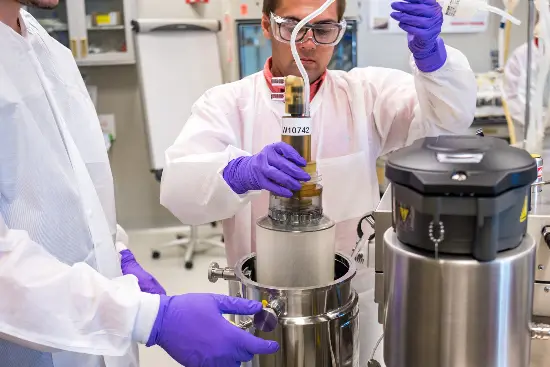Bioprocessing – cell separation in particular – is essential to the production of cell and gene therapies, synthetically cultured biologics, and laboratory-grown meats. Cell separation techniques enable protein purification and the removal of contaminants like media, reagents, and cell particles. In this article, we will explore how the processing speed of cell separation methods impacts product quality, process efficiency, and overall economics.
Balancing flow rate and separation efficiency via processing speed
In the context of cell separation, processing speed refers to the time required to separate a defined volume of cell culture, typically measured in liters of material processed per unit of time. To achieve optimal processing speed, flow rate and g-force must be calibrated to enable the desired separation efficiency while maintaining product quality attributes.
Centrifuges play a key role in cell separation processes, as they can be tuned to balance separation efficiency while accomplishing other goals such as processing speed and, ultimately, product quality. When selecting a centrifuge or cell separation technology, several factors need to be considered to achieve desired processing speeds: Total volume to be processed, minimum and maximum flow rates, and minimum and maximum gravitational forces (g forces).
Processing speed considerations across various cell separation options
Fluidized bed performance is directly linked to processing speed, where the flow of fluid is counter-current to the g force. This inverse relationship can become a critical issue when flow rates exceed the settling speed of solids. When that happens, all solids may be lost into the supernatant, posing a substantial risk to yield and process efficiency when compared to tubular bowl centrifuges.
For manufacturers that need to optimize processing speed and efficiency, choosing the right centrifuge for the application at hand is essential. Stainless steel (SS) disc stack centrifuges generally allow for higher processing speeds than SS tubular bowl centrifuges. However, that’s not the case when it comes to single-use (SU) centrifugation, which for many manufacturers has become a more sustainable and cost-effective option – requiring less capital, operational, and facility expenditures – than their SS counterparts.
In the SU realm, tubular bowl and disc stack centrifuges are highly comparable in terms of top processing speeds. Here, tubular bowl’s inherently low-shear design as well as its tunable parameters for flow and force may unlock several key advantages over disc stack centrifugation.
Processing speed and its impact on various bioprocessing applications
During some bioprocessing applications, processing speed can primarily be an economic consideration, determining how much product can be produced during a given time relative to overhead costs, while accounting for the operational capacity of equipment and the facility. This is often expressed as the maximum amount of drug product a manufacturer can produce in a year.
In other cases, processing speed is not only about capacity but also about protecting product quality and the total yield of high-functioning biologics. This is particularly significant for whole-cell and biologic therapies destined for therapeutic use, where processing time can potentially impact the final product, rendering some portions of cells unviable or unhealthy. These cells would be unacceptable for therapeutic efficacy and are highly disruptive to achieving therapeutic requirements, process efficiency, and economic targets. Finding the right balance between speed and quality is critically important.
Reaching full potential with tunable tubular bowl centrifugation
Whether performing protein purification or isolating whole-cell therapeutics, achieving the right processing speed for each unique bioprocessing application is a multifaceted challenge. It requires careful consideration of available equipment, process parameters, and the specific cell culture characteristics of the application at hand.
Balancing speed, efficiency, and quality is key to unlocking the full potential of bioprocessing in the ever-evolving areas of biotechnology and pharmaceuticals. Single-use tubular bowl centrifuges are sustainable, economical, high-performing, and tunable by design – allowing manufacturers to seamlessly adjust processing time, flow rate, and g forces to best suit each unique cell separation application.
If you are looking for a partner who brings expertise, innovation, and a focus on advancing the field of cell separation for the production of cell and gene therapies, synthetically cultured biologics, and laboratory-grown meats, contact CARR Biosystems for a free consultation.





